FNSACC503 - Manage Budgets and Forecasts: Assessment Workbook
VerifiedAdded on 2020/04/21
|30
|6417
|344
Homework Assignment
AI Summary
This assessment workbook, designed for the FNSACC503 unit on managing budgets and forecasts, covers essential aspects of financial planning and control. The workbook includes a variety of question types, such as short-answer questions, exercises, and a practical case study, to test the student's understanding of budgeting principles, forecasting methods, and financial analysis. The student's responses demonstrate an understanding of the purpose of budgeting, the budgeting process, benefits and limitations of budgeting, and various types of budgets. The assessment also covers forecasting techniques, cost calculations, cash budget components, and the application of responsibility accounting. The workbook provides a comprehensive overview of financial management concepts, offering practical examples and calculations relevant to real-world business scenarios. The student's answers demonstrate their ability to analyze financial data, make informed decisions, and apply budgeting techniques to improve financial performance.
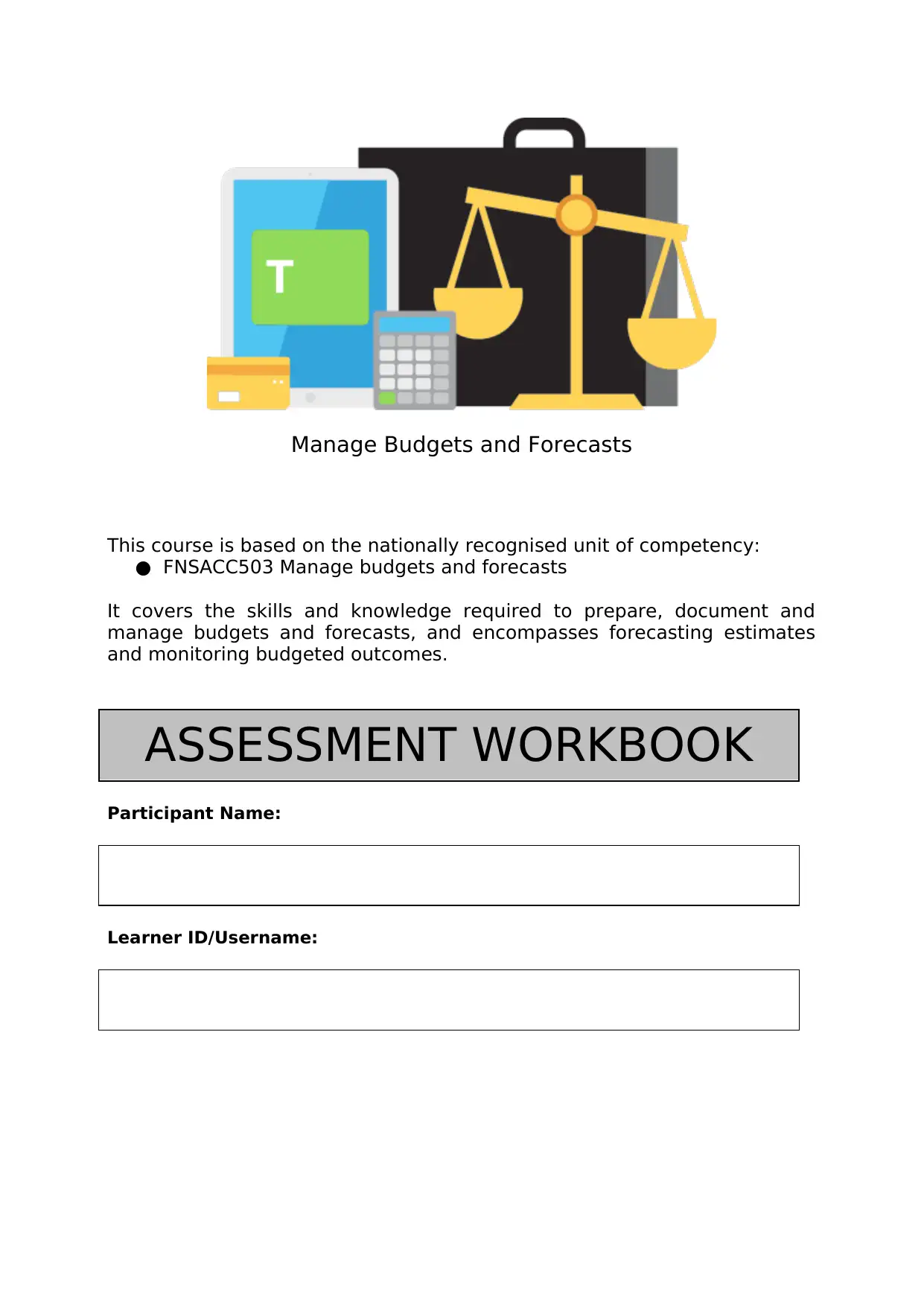
Manage Budgets and Forecasts
This course is based on the nationally recognised unit of competency:
● FNSACC503 Manage budgets and forecasts
It covers the skills and knowledge required to prepare, document and
manage budgets and forecasts, and encompasses forecasting estimates
and monitoring budgeted outcomes.
ASSESSMENT WORKBOOK
Participant Name:
Learner ID/Username:
This course is based on the nationally recognised unit of competency:
● FNSACC503 Manage budgets and forecasts
It covers the skills and knowledge required to prepare, document and
manage budgets and forecasts, and encompasses forecasting estimates
and monitoring budgeted outcomes.
ASSESSMENT WORKBOOK
Participant Name:
Learner ID/Username:
Paraphrase This Document
Need a fresh take? Get an instant paraphrase of this document with our AI Paraphraser
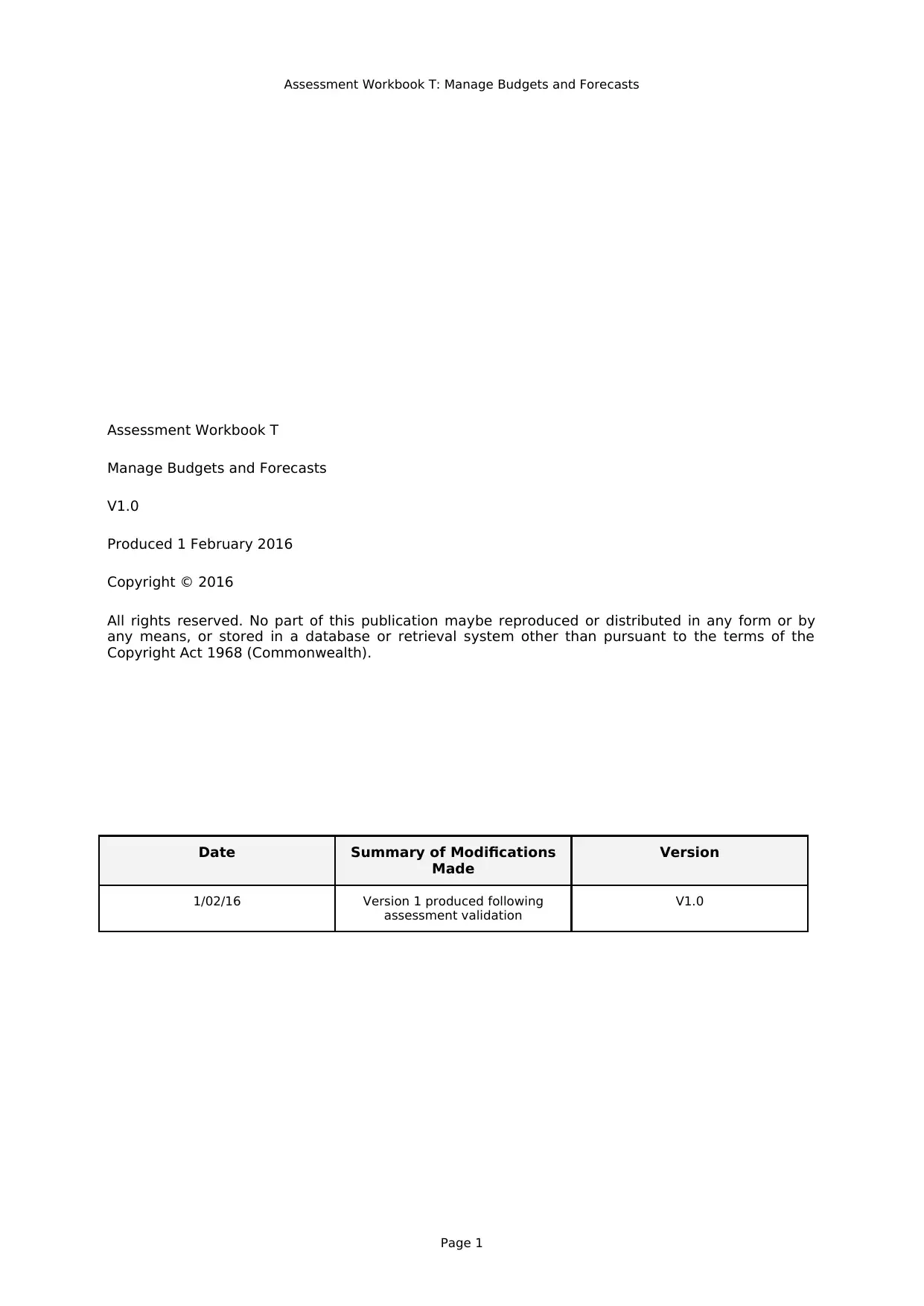
Assessment Workbook T: Manage Budgets and Forecasts
Assessment Workbook T
Manage Budgets and Forecasts
V1.0
Produced 1 February 2016
Copyright © 2016
All rights reserved. No part of this publication maybe reproduced or distributed in any form or by
any means, or stored in a database or retrieval system other than pursuant to the terms of the
Copyright Act 1968 (Commonwealth).
Date Summary of Modifications
Made
Version
1/02/16 Version 1 produced following
assessment validation
V1.0
Page 1
Assessment Workbook T
Manage Budgets and Forecasts
V1.0
Produced 1 February 2016
Copyright © 2016
All rights reserved. No part of this publication maybe reproduced or distributed in any form or by
any means, or stored in a database or retrieval system other than pursuant to the terms of the
Copyright Act 1968 (Commonwealth).
Date Summary of Modifications
Made
Version
1/02/16 Version 1 produced following
assessment validation
V1.0
Page 1
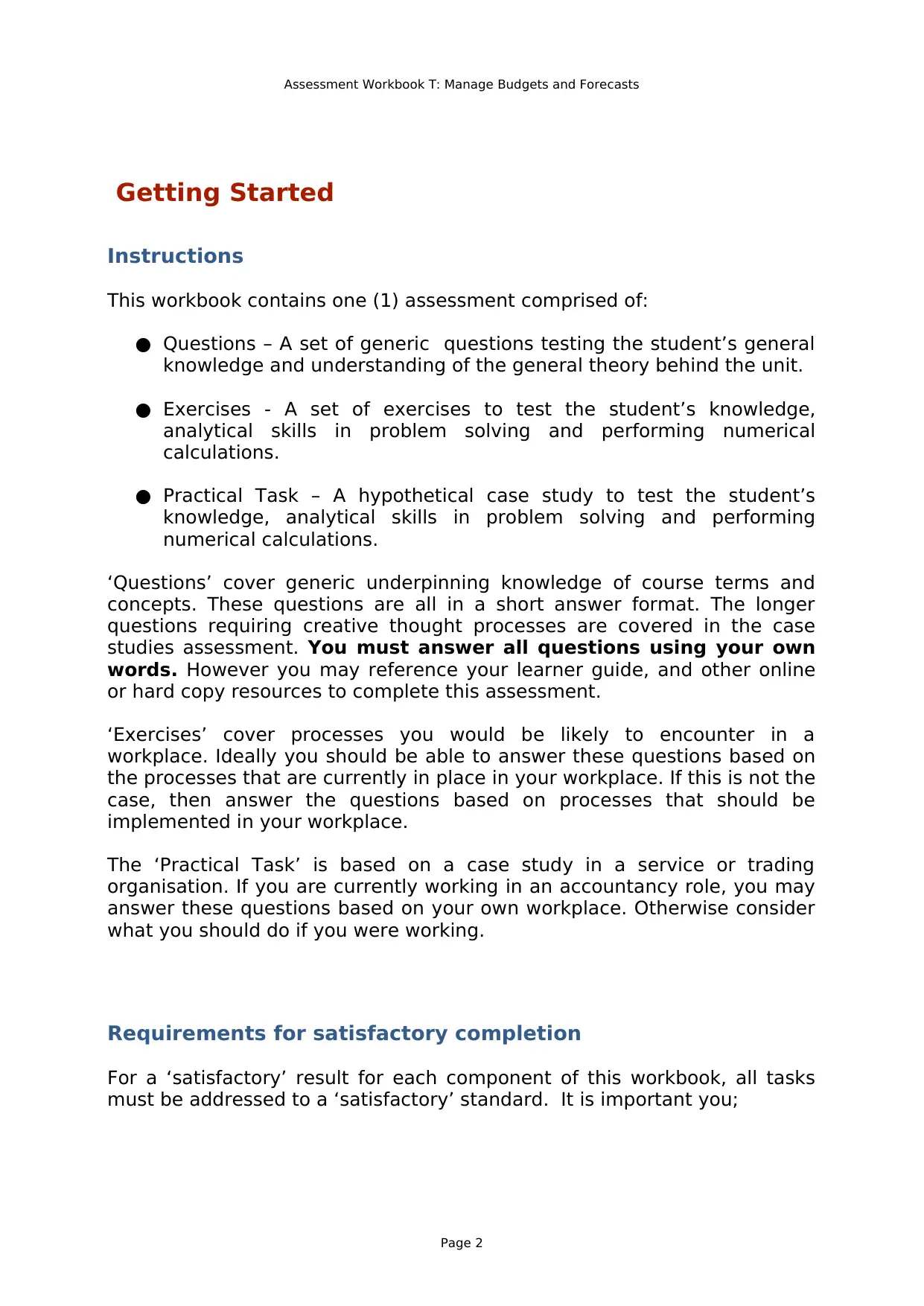
Assessment Workbook T: Manage Budgets and Forecasts
Getting Started
Instructions
This workbook contains one (1) assessment comprised of:
● Questions – A set of generic questions testing the student’s general
knowledge and understanding of the general theory behind the unit.
● Exercises - A set of exercises to test the student’s knowledge,
analytical skills in problem solving and performing numerical
calculations.
● Practical Task – A hypothetical case study to test the student’s
knowledge, analytical skills in problem solving and performing
numerical calculations.
‘Questions’ cover generic underpinning knowledge of course terms and
concepts. These questions are all in a short answer format. The longer
questions requiring creative thought processes are covered in the case
studies assessment. You must answer all questions using your own
words. However you may reference your learner guide, and other online
or hard copy resources to complete this assessment.
‘Exercises’ cover processes you would be likely to encounter in a
workplace. Ideally you should be able to answer these questions based on
the processes that are currently in place in your workplace. If this is not the
case, then answer the questions based on processes that should be
implemented in your workplace.
The ‘Practical Task’ is based on a case study in a service or trading
organisation. If you are currently working in an accountancy role, you may
answer these questions based on your own workplace. Otherwise consider
what you should do if you were working.
Requirements for satisfactory completion
For a ‘satisfactory’ result for each component of this workbook, all tasks
must be addressed to a ‘satisfactory’ standard. It is important you;
Page 2
Getting Started
Instructions
This workbook contains one (1) assessment comprised of:
● Questions – A set of generic questions testing the student’s general
knowledge and understanding of the general theory behind the unit.
● Exercises - A set of exercises to test the student’s knowledge,
analytical skills in problem solving and performing numerical
calculations.
● Practical Task – A hypothetical case study to test the student’s
knowledge, analytical skills in problem solving and performing
numerical calculations.
‘Questions’ cover generic underpinning knowledge of course terms and
concepts. These questions are all in a short answer format. The longer
questions requiring creative thought processes are covered in the case
studies assessment. You must answer all questions using your own
words. However you may reference your learner guide, and other online
or hard copy resources to complete this assessment.
‘Exercises’ cover processes you would be likely to encounter in a
workplace. Ideally you should be able to answer these questions based on
the processes that are currently in place in your workplace. If this is not the
case, then answer the questions based on processes that should be
implemented in your workplace.
The ‘Practical Task’ is based on a case study in a service or trading
organisation. If you are currently working in an accountancy role, you may
answer these questions based on your own workplace. Otherwise consider
what you should do if you were working.
Requirements for satisfactory completion
For a ‘satisfactory’ result for each component of this workbook, all tasks
must be addressed to a ‘satisfactory’ standard. It is important you;
Page 2
⊘ This is a preview!⊘
Do you want full access?
Subscribe today to unlock all pages.

Trusted by 1+ million students worldwide
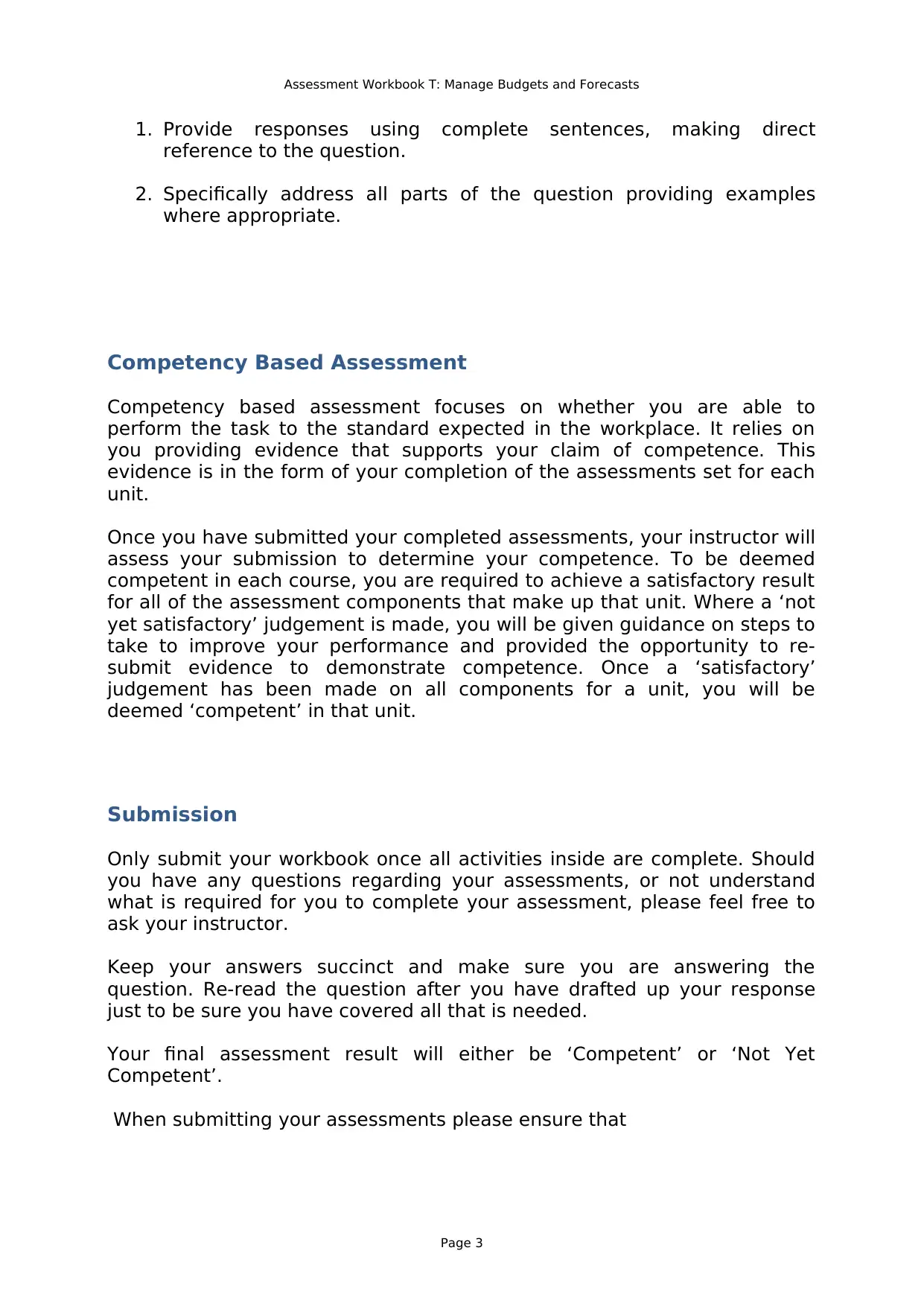
Assessment Workbook T: Manage Budgets and Forecasts
1. Provide responses using complete sentences, making direct
reference to the question.
2. Specifically address all parts of the question providing examples
where appropriate.
Competency Based Assessment
Competency based assessment focuses on whether you are able to
perform the task to the standard expected in the workplace. It relies on
you providing evidence that supports your claim of competence. This
evidence is in the form of your completion of the assessments set for each
unit.
Once you have submitted your completed assessments, your instructor will
assess your submission to determine your competence. To be deemed
competent in each course, you are required to achieve a satisfactory result
for all of the assessment components that make up that unit. Where a ‘not
yet satisfactory’ judgement is made, you will be given guidance on steps to
take to improve your performance and provided the opportunity to re-
submit evidence to demonstrate competence. Once a ‘satisfactory’
judgement has been made on all components for a unit, you will be
deemed ‘competent’ in that unit.
Submission
Only submit your workbook once all activities inside are complete. Should
you have any questions regarding your assessments, or not understand
what is required for you to complete your assessment, please feel free to
ask your instructor.
Keep your answers succinct and make sure you are answering the
question. Re-read the question after you have drafted up your response
just to be sure you have covered all that is needed.
Your final assessment result will either be ‘Competent’ or ‘Not Yet
Competent’.
When submitting your assessments please ensure that
Page 3
1. Provide responses using complete sentences, making direct
reference to the question.
2. Specifically address all parts of the question providing examples
where appropriate.
Competency Based Assessment
Competency based assessment focuses on whether you are able to
perform the task to the standard expected in the workplace. It relies on
you providing evidence that supports your claim of competence. This
evidence is in the form of your completion of the assessments set for each
unit.
Once you have submitted your completed assessments, your instructor will
assess your submission to determine your competence. To be deemed
competent in each course, you are required to achieve a satisfactory result
for all of the assessment components that make up that unit. Where a ‘not
yet satisfactory’ judgement is made, you will be given guidance on steps to
take to improve your performance and provided the opportunity to re-
submit evidence to demonstrate competence. Once a ‘satisfactory’
judgement has been made on all components for a unit, you will be
deemed ‘competent’ in that unit.
Submission
Only submit your workbook once all activities inside are complete. Should
you have any questions regarding your assessments, or not understand
what is required for you to complete your assessment, please feel free to
ask your instructor.
Keep your answers succinct and make sure you are answering the
question. Re-read the question after you have drafted up your response
just to be sure you have covered all that is needed.
Your final assessment result will either be ‘Competent’ or ‘Not Yet
Competent’.
When submitting your assessments please ensure that
Page 3
Paraphrase This Document
Need a fresh take? Get an instant paraphrase of this document with our AI Paraphraser
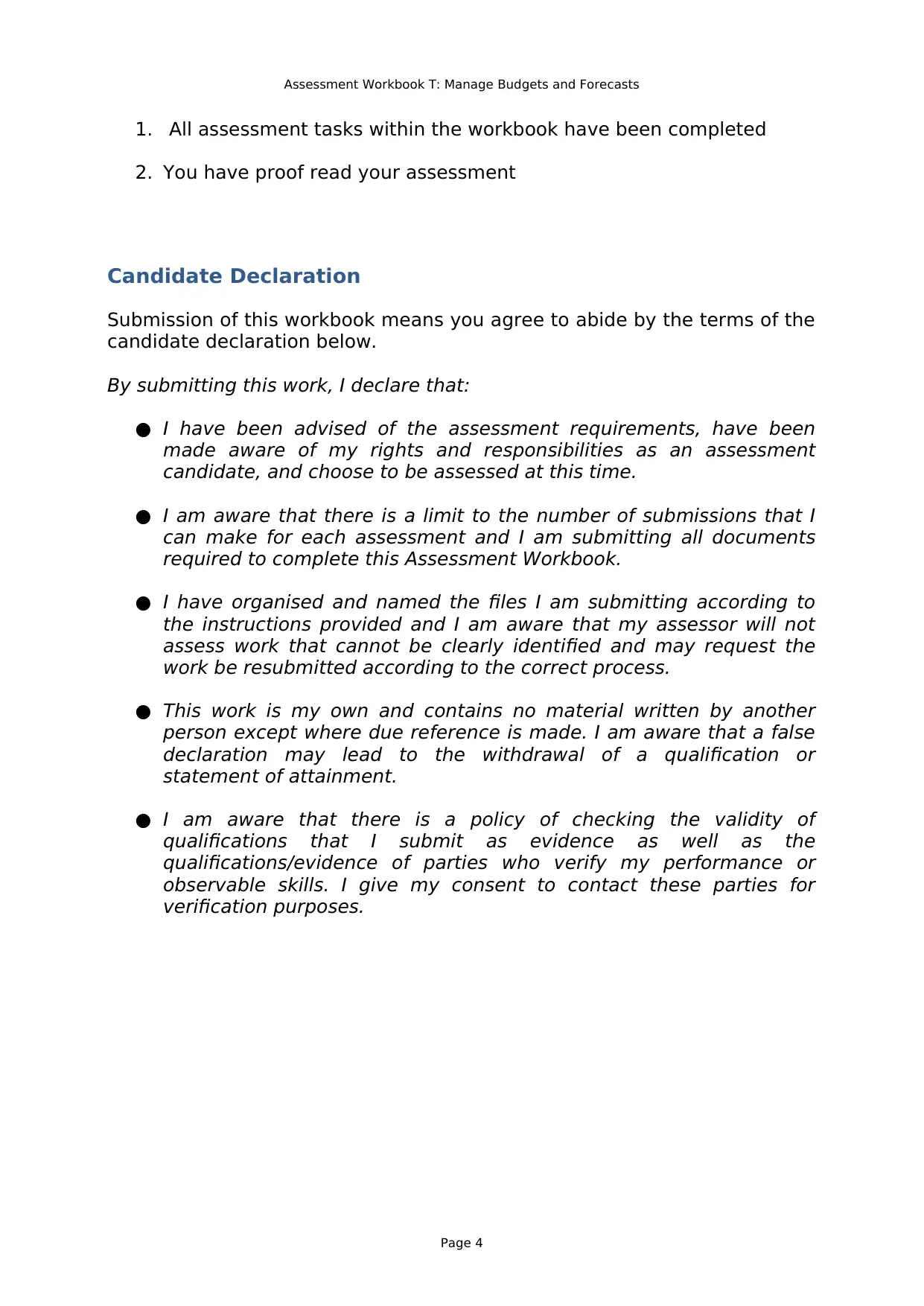
Assessment Workbook T: Manage Budgets and Forecasts
1. All assessment tasks within the workbook have been completed
2. You have proof read your assessment
Candidate Declaration
Submission of this workbook means you agree to abide by the terms of the
candidate declaration below.
By submitting this work, I declare that:
● I have been advised of the assessment requirements, have been
made aware of my rights and responsibilities as an assessment
candidate, and choose to be assessed at this time.
● I am aware that there is a limit to the number of submissions that I
can make for each assessment and I am submitting all documents
required to complete this Assessment Workbook.
● I have organised and named the files I am submitting according to
the instructions provided and I am aware that my assessor will not
assess work that cannot be clearly identified and may request the
work be resubmitted according to the correct process.
● This work is my own and contains no material written by another
person except where due reference is made. I am aware that a false
declaration may lead to the withdrawal of a qualification or
statement of attainment.
● I am aware that there is a policy of checking the validity of
qualifications that I submit as evidence as well as the
qualifications/evidence of parties who verify my performance or
observable skills. I give my consent to contact these parties for
verification purposes.
Page 4
1. All assessment tasks within the workbook have been completed
2. You have proof read your assessment
Candidate Declaration
Submission of this workbook means you agree to abide by the terms of the
candidate declaration below.
By submitting this work, I declare that:
● I have been advised of the assessment requirements, have been
made aware of my rights and responsibilities as an assessment
candidate, and choose to be assessed at this time.
● I am aware that there is a limit to the number of submissions that I
can make for each assessment and I am submitting all documents
required to complete this Assessment Workbook.
● I have organised and named the files I am submitting according to
the instructions provided and I am aware that my assessor will not
assess work that cannot be clearly identified and may request the
work be resubmitted according to the correct process.
● This work is my own and contains no material written by another
person except where due reference is made. I am aware that a false
declaration may lead to the withdrawal of a qualification or
statement of attainment.
● I am aware that there is a policy of checking the validity of
qualifications that I submit as evidence as well as the
qualifications/evidence of parties who verify my performance or
observable skills. I give my consent to contact these parties for
verification purposes.
Page 4
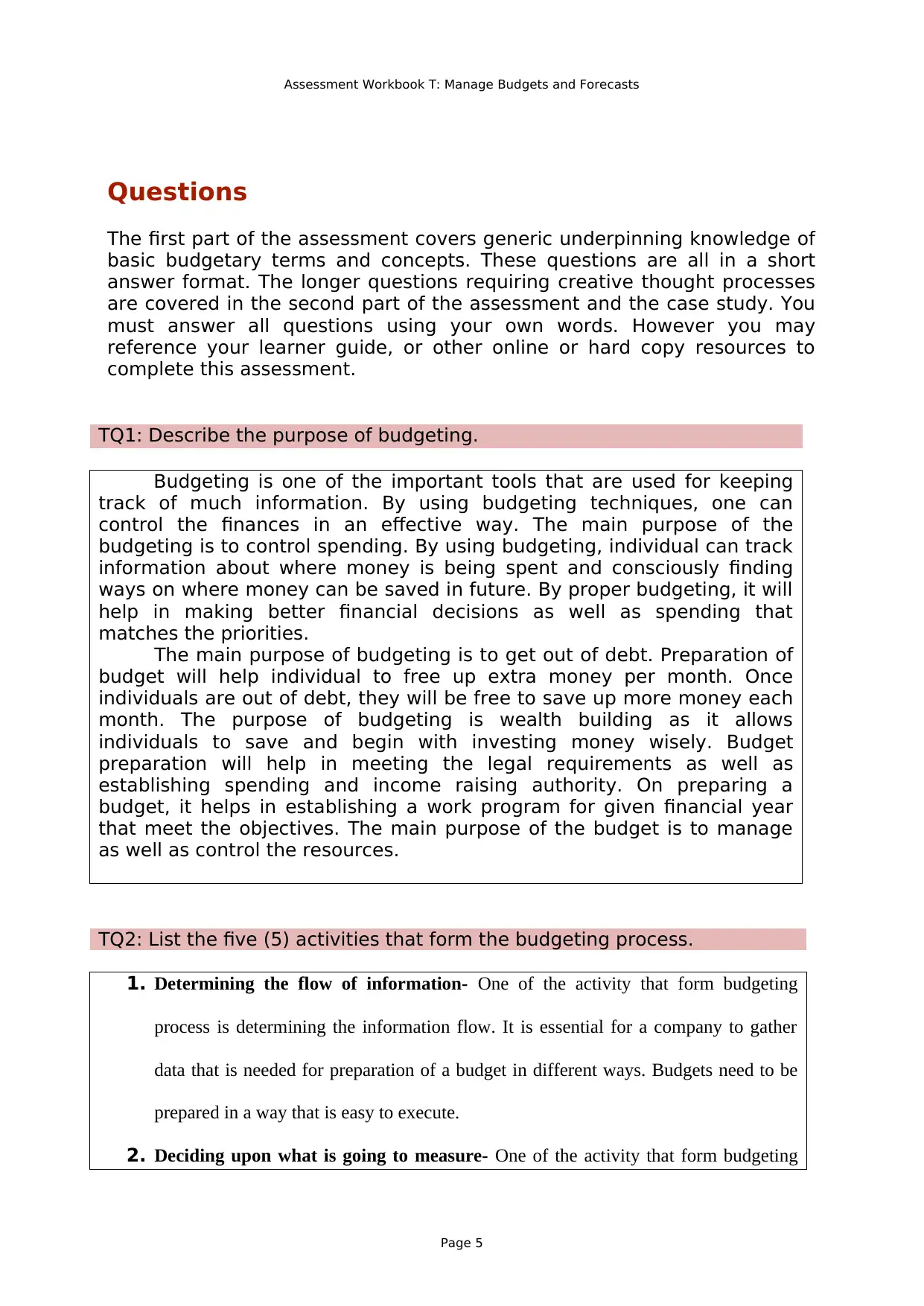
Assessment Workbook T: Manage Budgets and Forecasts
Questions
The first part of the assessment covers generic underpinning knowledge of
basic budgetary terms and concepts. These questions are all in a short
answer format. The longer questions requiring creative thought processes
are covered in the second part of the assessment and the case study. You
must answer all questions using your own words. However you may
reference your learner guide, or other online or hard copy resources to
complete this assessment.
TQ1: Describe the purpose of budgeting.
Budgeting is one of the important tools that are used for keeping
track of much information. By using budgeting techniques, one can
control the finances in an effective way. The main purpose of the
budgeting is to control spending. By using budgeting, individual can track
information about where money is being spent and consciously finding
ways on where money can be saved in future. By proper budgeting, it will
help in making better financial decisions as well as spending that
matches the priorities.
The main purpose of budgeting is to get out of debt. Preparation of
budget will help individual to free up extra money per month. Once
individuals are out of debt, they will be free to save up more money each
month. The purpose of budgeting is wealth building as it allows
individuals to save and begin with investing money wisely. Budget
preparation will help in meeting the legal requirements as well as
establishing spending and income raising authority. On preparing a
budget, it helps in establishing a work program for given financial year
that meet the objectives. The main purpose of the budget is to manage
as well as control the resources.
TQ2: List the five (5) activities that form the budgeting process.
1. Determining the flow of information- One of the activity that form budgeting
process is determining the information flow. It is essential for a company to gather
data that is needed for preparation of a budget in different ways. Budgets need to be
prepared in a way that is easy to execute.
2. Deciding upon what is going to measure- One of the activity that form budgeting
Page 5
Questions
The first part of the assessment covers generic underpinning knowledge of
basic budgetary terms and concepts. These questions are all in a short
answer format. The longer questions requiring creative thought processes
are covered in the second part of the assessment and the case study. You
must answer all questions using your own words. However you may
reference your learner guide, or other online or hard copy resources to
complete this assessment.
TQ1: Describe the purpose of budgeting.
Budgeting is one of the important tools that are used for keeping
track of much information. By using budgeting techniques, one can
control the finances in an effective way. The main purpose of the
budgeting is to control spending. By using budgeting, individual can track
information about where money is being spent and consciously finding
ways on where money can be saved in future. By proper budgeting, it will
help in making better financial decisions as well as spending that
matches the priorities.
The main purpose of budgeting is to get out of debt. Preparation of
budget will help individual to free up extra money per month. Once
individuals are out of debt, they will be free to save up more money each
month. The purpose of budgeting is wealth building as it allows
individuals to save and begin with investing money wisely. Budget
preparation will help in meeting the legal requirements as well as
establishing spending and income raising authority. On preparing a
budget, it helps in establishing a work program for given financial year
that meet the objectives. The main purpose of the budget is to manage
as well as control the resources.
TQ2: List the five (5) activities that form the budgeting process.
1. Determining the flow of information- One of the activity that form budgeting
process is determining the information flow. It is essential for a company to gather
data that is needed for preparation of a budget in different ways. Budgets need to be
prepared in a way that is easy to execute.
2. Deciding upon what is going to measure- One of the activity that form budgeting
Page 5
⊘ This is a preview!⊘
Do you want full access?
Subscribe today to unlock all pages.

Trusted by 1+ million students worldwide
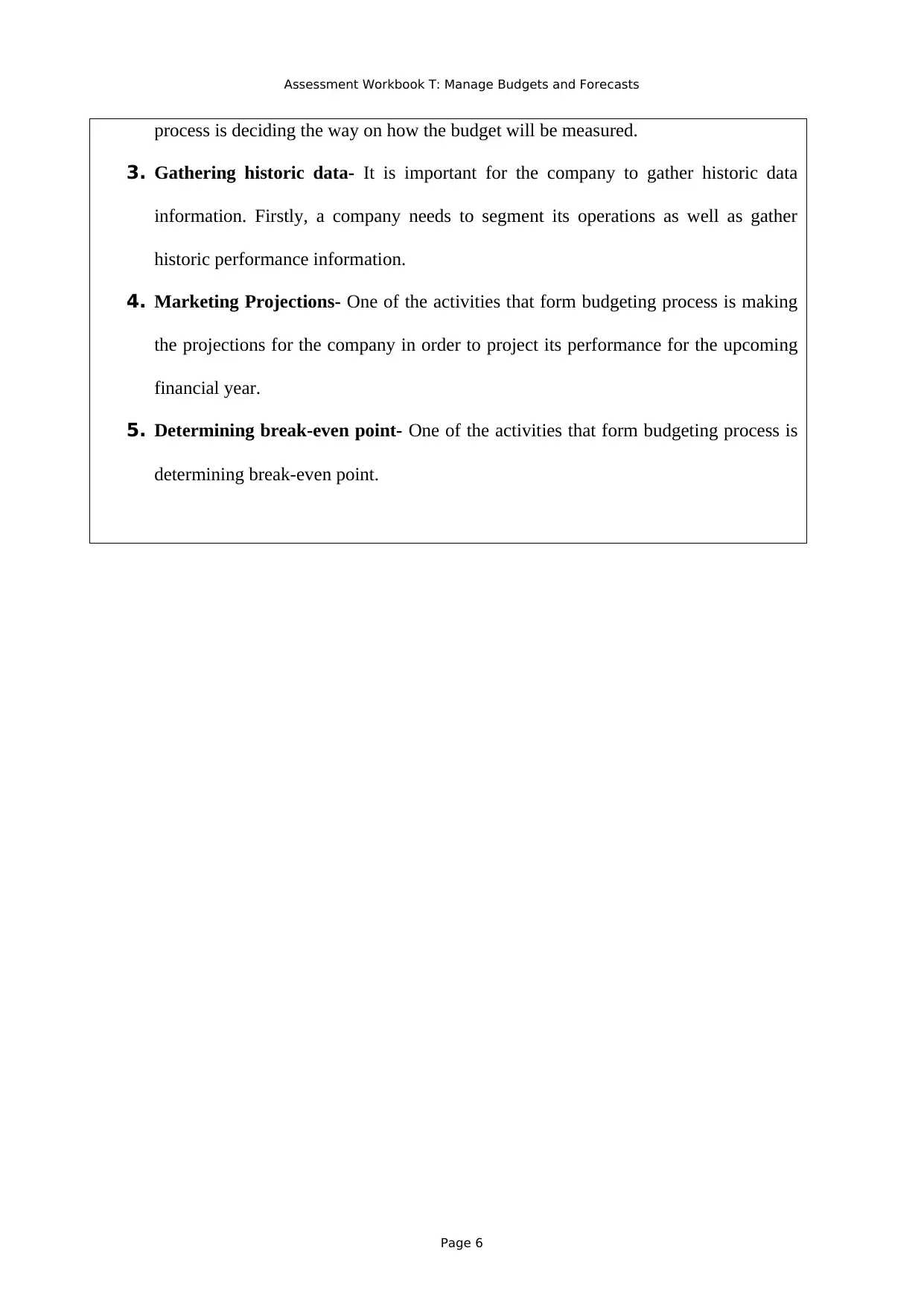
Assessment Workbook T: Manage Budgets and Forecasts
process is deciding the way on how the budget will be measured.
3. Gathering historic data- It is important for the company to gather historic data
information. Firstly, a company needs to segment its operations as well as gather
historic performance information.
4. Marketing Projections- One of the activities that form budgeting process is making
the projections for the company in order to project its performance for the upcoming
financial year.
5. Determining break-even point- One of the activities that form budgeting process is
determining break-even point.
Page 6
process is deciding the way on how the budget will be measured.
3. Gathering historic data- It is important for the company to gather historic data
information. Firstly, a company needs to segment its operations as well as gather
historic performance information.
4. Marketing Projections- One of the activities that form budgeting process is making
the projections for the company in order to project its performance for the upcoming
financial year.
5. Determining break-even point- One of the activities that form budgeting process is
determining break-even point.
Page 6
Paraphrase This Document
Need a fresh take? Get an instant paraphrase of this document with our AI Paraphraser
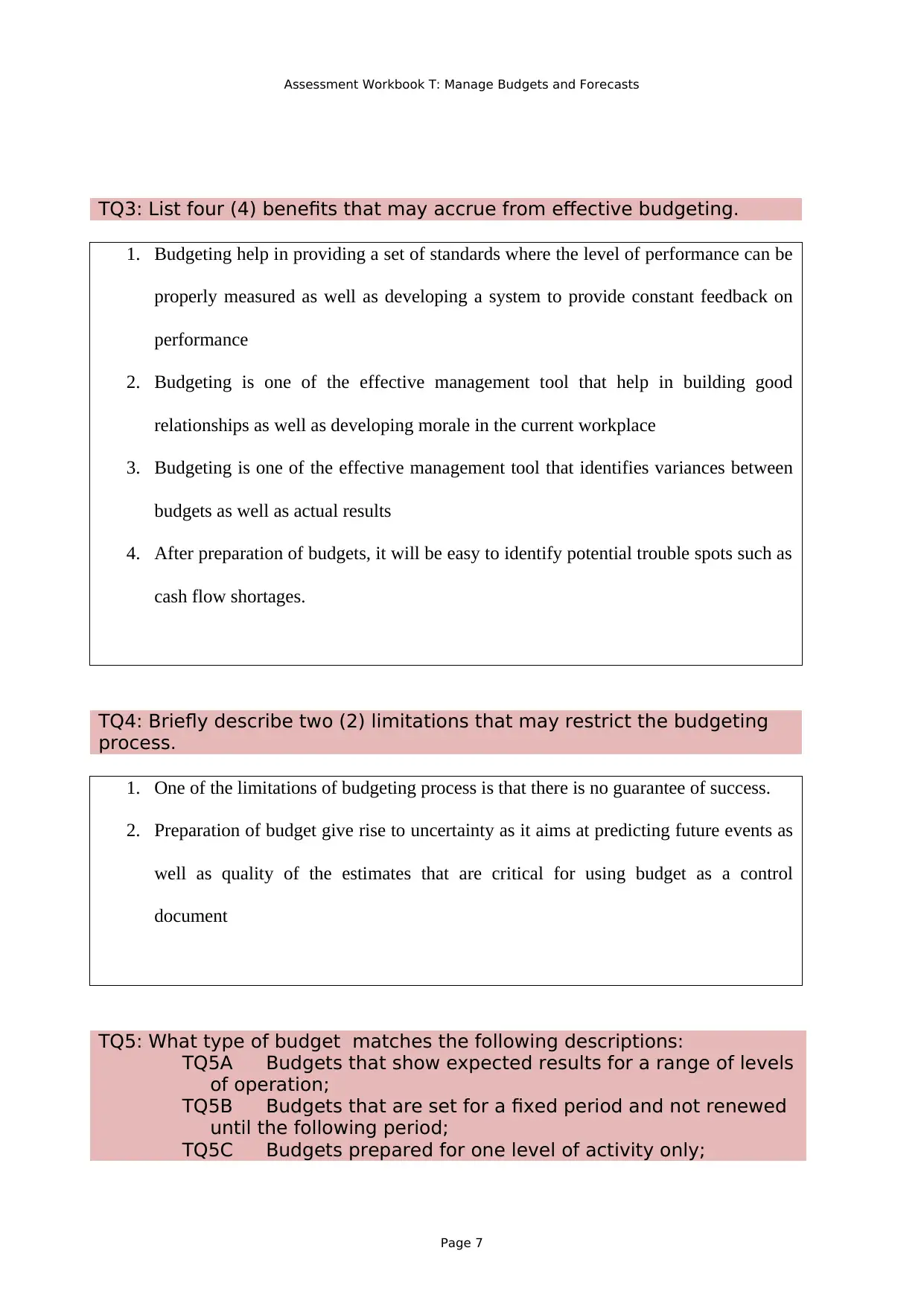
Assessment Workbook T: Manage Budgets and Forecasts
TQ3: List four (4) benefits that may accrue from effective budgeting.
1. Budgeting help in providing a set of standards where the level of performance can be
properly measured as well as developing a system to provide constant feedback on
performance
2. Budgeting is one of the effective management tool that help in building good
relationships as well as developing morale in the current workplace
3. Budgeting is one of the effective management tool that identifies variances between
budgets as well as actual results
4. After preparation of budgets, it will be easy to identify potential trouble spots such as
cash flow shortages.
TQ4: Briefly describe two (2) limitations that may restrict the budgeting
process.
1. One of the limitations of budgeting process is that there is no guarantee of success.
2. Preparation of budget give rise to uncertainty as it aims at predicting future events as
well as quality of the estimates that are critical for using budget as a control
document
TQ5: What type of budget matches the following descriptions:
TQ5A Budgets that show expected results for a range of levels
of operation;
TQ5B Budgets that are set for a fixed period and not renewed
until the following period;
TQ5C Budgets prepared for one level of activity only;
Page 7
TQ3: List four (4) benefits that may accrue from effective budgeting.
1. Budgeting help in providing a set of standards where the level of performance can be
properly measured as well as developing a system to provide constant feedback on
performance
2. Budgeting is one of the effective management tool that help in building good
relationships as well as developing morale in the current workplace
3. Budgeting is one of the effective management tool that identifies variances between
budgets as well as actual results
4. After preparation of budgets, it will be easy to identify potential trouble spots such as
cash flow shortages.
TQ4: Briefly describe two (2) limitations that may restrict the budgeting
process.
1. One of the limitations of budgeting process is that there is no guarantee of success.
2. Preparation of budget give rise to uncertainty as it aims at predicting future events as
well as quality of the estimates that are critical for using budget as a control
document
TQ5: What type of budget matches the following descriptions:
TQ5A Budgets that show expected results for a range of levels
of operation;
TQ5B Budgets that are set for a fixed period and not renewed
until the following period;
TQ5C Budgets prepared for one level of activity only;
Page 7
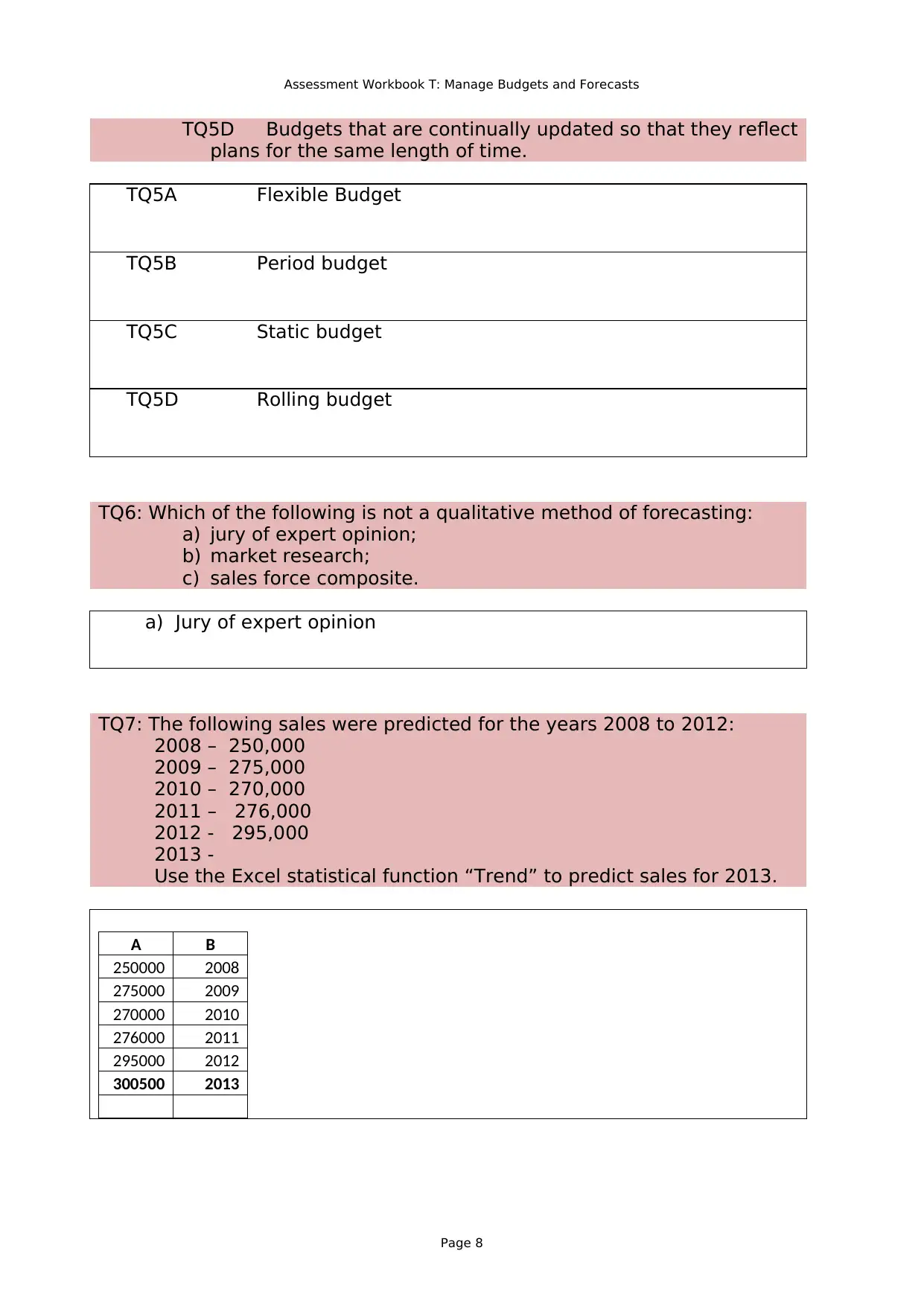
Assessment Workbook T: Manage Budgets and Forecasts
TQ5D Budgets that are continually updated so that they reflect
plans for the same length of time.
TQ5A Flexible Budget
TQ5B Period budget
TQ5C Static budget
TQ5D Rolling budget
TQ6: Which of the following is not a qualitative method of forecasting:
a) jury of expert opinion;
b) market research;
c) sales force composite.
a) Jury of expert opinion
TQ7: The following sales were predicted for the years 2008 to 2012:
2008 – 250,000
2009 – 275,000
2010 – 270,000
2011 – 276,000
2012 - 295,000
2013 -
Use the Excel statistical function “Trend” to predict sales for 2013.
A B
250000 2008
275000 2009
270000 2010
276000 2011
295000 2012
300500 2013
Page 8
TQ5D Budgets that are continually updated so that they reflect
plans for the same length of time.
TQ5A Flexible Budget
TQ5B Period budget
TQ5C Static budget
TQ5D Rolling budget
TQ6: Which of the following is not a qualitative method of forecasting:
a) jury of expert opinion;
b) market research;
c) sales force composite.
a) Jury of expert opinion
TQ7: The following sales were predicted for the years 2008 to 2012:
2008 – 250,000
2009 – 275,000
2010 – 270,000
2011 – 276,000
2012 - 295,000
2013 -
Use the Excel statistical function “Trend” to predict sales for 2013.
A B
250000 2008
275000 2009
270000 2010
276000 2011
295000 2012
300500 2013
Page 8
⊘ This is a preview!⊘
Do you want full access?
Subscribe today to unlock all pages.

Trusted by 1+ million students worldwide
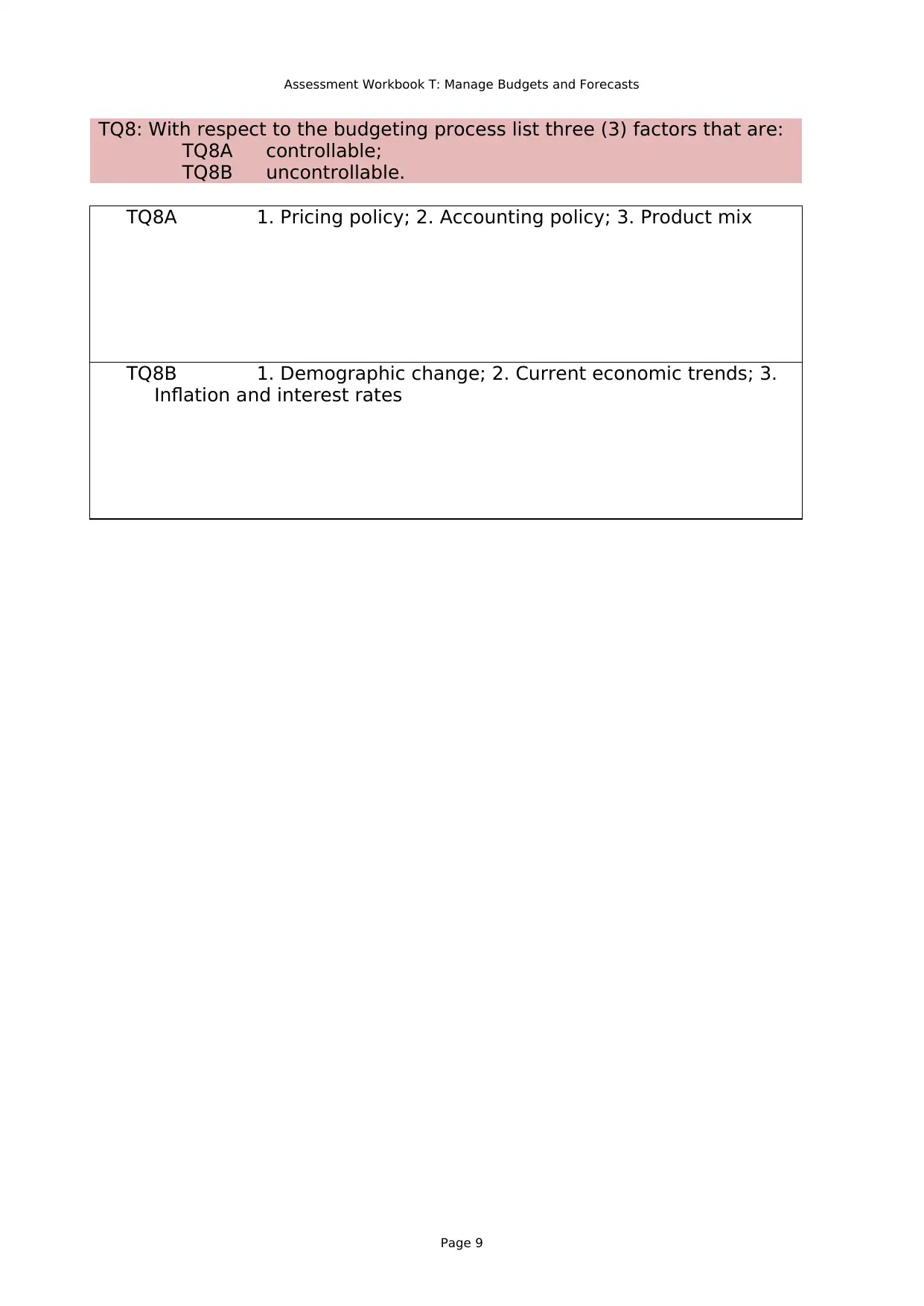
Assessment Workbook T: Manage Budgets and Forecasts
TQ8: With respect to the budgeting process list three (3) factors that are:
TQ8A controllable;
TQ8B uncontrollable.
TQ8A 1. Pricing policy; 2. Accounting policy; 3. Product mix
TQ8B 1. Demographic change; 2. Current economic trends; 3.
Inflation and interest rates
Page 9
TQ8: With respect to the budgeting process list three (3) factors that are:
TQ8A controllable;
TQ8B uncontrollable.
TQ8A 1. Pricing policy; 2. Accounting policy; 3. Product mix
TQ8B 1. Demographic change; 2. Current economic trends; 3.
Inflation and interest rates
Page 9
Paraphrase This Document
Need a fresh take? Get an instant paraphrase of this document with our AI Paraphraser
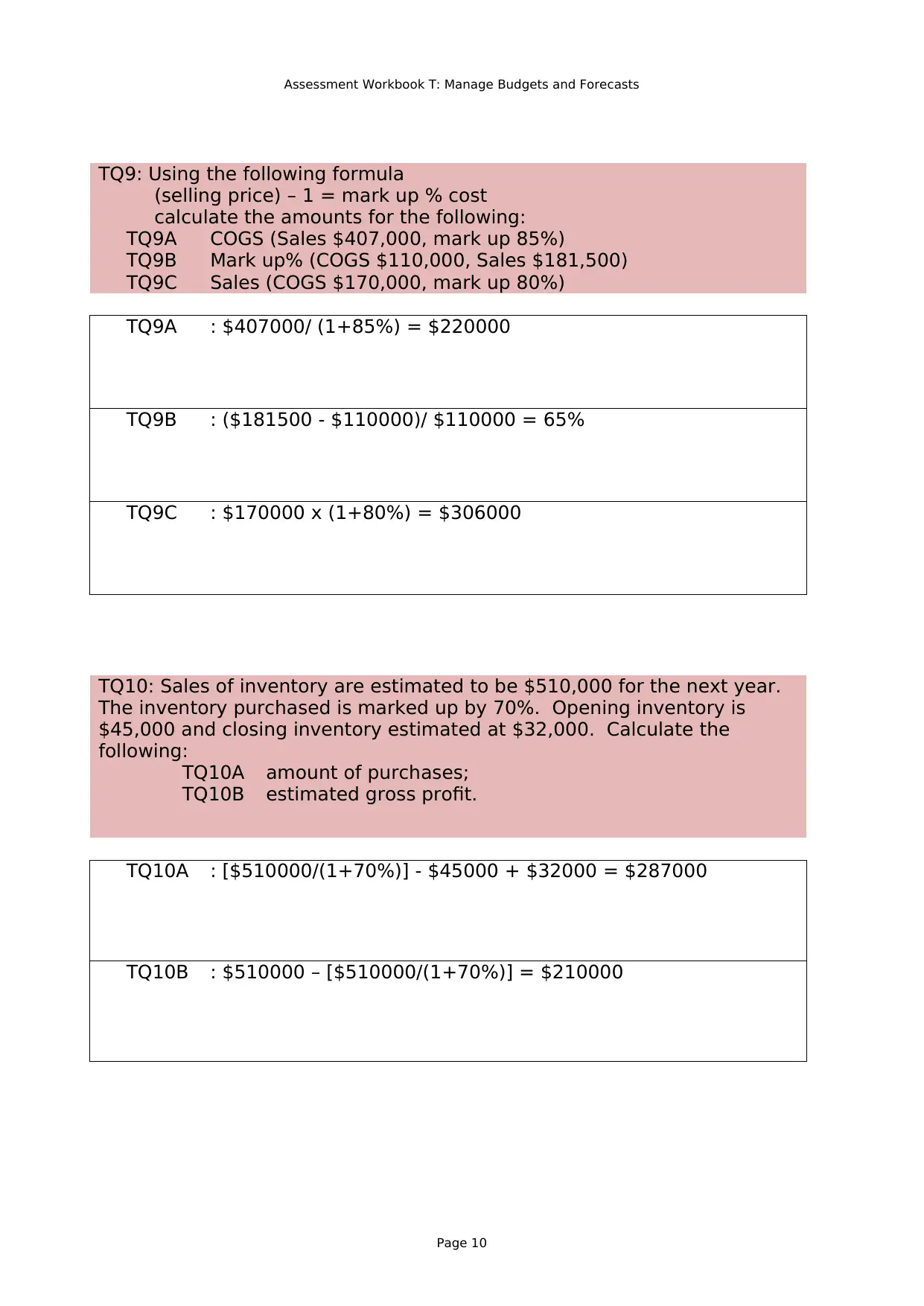
Assessment Workbook T: Manage Budgets and Forecasts
TQ9: Using the following formula
(selling price) – 1 = mark up % cost
calculate the amounts for the following:
TQ9A COGS (Sales $407,000, mark up 85%)
TQ9B Mark up% (COGS $110,000, Sales $181,500)
TQ9C Sales (COGS $170,000, mark up 80%)
TQ9A : $407000/ (1+85%) = $220000
TQ9B : ($181500 - $110000)/ $110000 = 65%
TQ9C : $170000 x (1+80%) = $306000
TQ10: Sales of inventory are estimated to be $510,000 for the next year.
The inventory purchased is marked up by 70%. Opening inventory is
$45,000 and closing inventory estimated at $32,000. Calculate the
following:
TQ10A amount of purchases;
TQ10B estimated gross profit.
TQ10A : [$510000/(1+70%)] - $45000 + $32000 = $287000
TQ10B : $510000 – [$510000/(1+70%)] = $210000
Page 10
TQ9: Using the following formula
(selling price) – 1 = mark up % cost
calculate the amounts for the following:
TQ9A COGS (Sales $407,000, mark up 85%)
TQ9B Mark up% (COGS $110,000, Sales $181,500)
TQ9C Sales (COGS $170,000, mark up 80%)
TQ9A : $407000/ (1+85%) = $220000
TQ9B : ($181500 - $110000)/ $110000 = 65%
TQ9C : $170000 x (1+80%) = $306000
TQ10: Sales of inventory are estimated to be $510,000 for the next year.
The inventory purchased is marked up by 70%. Opening inventory is
$45,000 and closing inventory estimated at $32,000. Calculate the
following:
TQ10A amount of purchases;
TQ10B estimated gross profit.
TQ10A : [$510000/(1+70%)] - $45000 + $32000 = $287000
TQ10B : $510000 – [$510000/(1+70%)] = $210000
Page 10
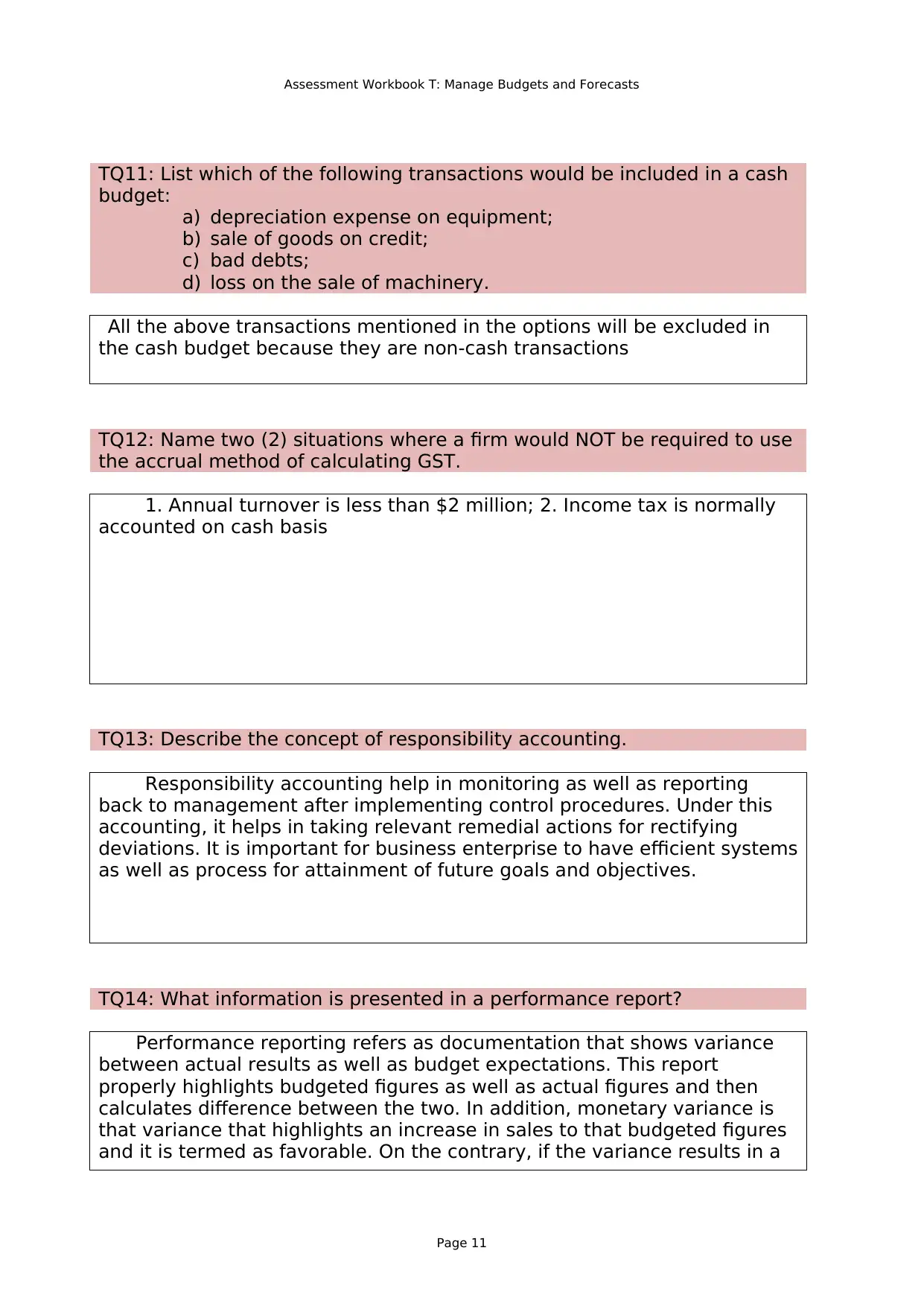
Assessment Workbook T: Manage Budgets and Forecasts
TQ11: List which of the following transactions would be included in a cash
budget:
a) depreciation expense on equipment;
b) sale of goods on credit;
c) bad debts;
d) loss on the sale of machinery.
All the above transactions mentioned in the options will be excluded in
the cash budget because they are non-cash transactions
TQ12: Name two (2) situations where a firm would NOT be required to use
the accrual method of calculating GST.
1. Annual turnover is less than $2 million; 2. Income tax is normally
accounted on cash basis
TQ13: Describe the concept of responsibility accounting.
Responsibility accounting help in monitoring as well as reporting
back to management after implementing control procedures. Under this
accounting, it helps in taking relevant remedial actions for rectifying
deviations. It is important for business enterprise to have efficient systems
as well as process for attainment of future goals and objectives.
TQ14: What information is presented in a performance report?
Performance reporting refers as documentation that shows variance
between actual results as well as budget expectations. This report
properly highlights budgeted figures as well as actual figures and then
calculates difference between the two. In addition, monetary variance is
that variance that highlights an increase in sales to that budgeted figures
and it is termed as favorable. On the contrary, if the variance results in a
Page 11
TQ11: List which of the following transactions would be included in a cash
budget:
a) depreciation expense on equipment;
b) sale of goods on credit;
c) bad debts;
d) loss on the sale of machinery.
All the above transactions mentioned in the options will be excluded in
the cash budget because they are non-cash transactions
TQ12: Name two (2) situations where a firm would NOT be required to use
the accrual method of calculating GST.
1. Annual turnover is less than $2 million; 2. Income tax is normally
accounted on cash basis
TQ13: Describe the concept of responsibility accounting.
Responsibility accounting help in monitoring as well as reporting
back to management after implementing control procedures. Under this
accounting, it helps in taking relevant remedial actions for rectifying
deviations. It is important for business enterprise to have efficient systems
as well as process for attainment of future goals and objectives.
TQ14: What information is presented in a performance report?
Performance reporting refers as documentation that shows variance
between actual results as well as budget expectations. This report
properly highlights budgeted figures as well as actual figures and then
calculates difference between the two. In addition, monetary variance is
that variance that highlights an increase in sales to that budgeted figures
and it is termed as favorable. On the contrary, if the variance results in a
Page 11
⊘ This is a preview!⊘
Do you want full access?
Subscribe today to unlock all pages.

Trusted by 1+ million students worldwide
1 out of 30
Related Documents
Your All-in-One AI-Powered Toolkit for Academic Success.
+13062052269
info@desklib.com
Available 24*7 on WhatsApp / Email
![[object Object]](/_next/static/media/star-bottom.7253800d.svg)
Unlock your academic potential
Copyright © 2020–2025 A2Z Services. All Rights Reserved. Developed and managed by ZUCOL.





